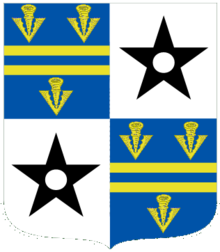John Smith (politician, 1656)
John Smith ( 1656 - October 2, 1723 ) from Tedworth House, Hampshire, was an English politician. He was a member of the English and British House of Commons between 1678 and 1723 . He was Speaker of the House of Commons and Chancellor of the Exchequer .
Smith was the fourth, only surviving son of John Smith of Tedworth House South Tidworth, Hampshire and his wife Mary Wright, daughter of Sir Edmund Wright, Alderman, of London. His sister Anne married Sir Samuel Dashwood, MP and Lord Mayor of London . At the age of 16, he enrolled at St John's College, Oxford on May 18, 1672 , and was accepted into the Middle Temple two years later . On September 1, 1679, he married Anne Steward, daughter of Sir Nicholas Steward, 1st Baronet, of Hartley Mauditt, Hampshire. But she died in 1680 and he married Anne Strickland, daughter of Sir Thomas Strickland of Boynton, Yorkshire on November 7, 1683. His father died in 1690 and his uncle Thomas Smith in 1692, whom he also inherited.
He and his second wife had four sons and two daughters. His son Thomas was also a MP for the Whigs.
Political career
Smith was a moderate Whig and became Member of Parliament for Ludgershall in February 1679. In the subsequent election in August of that year, he lost the seat again. In 1689 he was re-elected.
In a by-election on December 15, 1691, he became a Member of Parliament for Bere Alston. In 1694 he was appointed Lord of the Treasury and on May 23, 1695 he became a member of the Privy Council . He was an MP for Andover from 1695 to 1710. Between 1695 and 1697 he was Commissioner for Prize Appeals. From June 2, 1699 to March 27, 1701 he was Chancellor of the Exchequer. In 1705 he became Speaker of the House of Commons . In 1706 he became Commissioner for the Union with Scotland and the last Speaker of the House of Commons of England. After the Acts of Union 1707 he became the first speaker of the House of Commons of Great Britain. After the general election in 1708 he was no longer a speaker and was again Chancellor of the Exchequer on April 22, 1708. After the general election in 1710, he assumed the post of Teller of the Exchequer. In the 1713 elections he did not run and lost his post as Teller of the Exchequer. He held this again from 1714 until his death.
Smith was MP for East Looe in 1715 and 1722.
death
Smith was buried in the old church in South Tidworth.
Web links
Individual evidence
- ^ Foster, Joseph: 'Smith-Sowton', in Alumni Oxonienses 1500-1714, ed. Joseph Foster (Oxford, 1891), pp. 1368-1394 . British History Online. Retrieved November 28, 2018.
- ↑ SMITH, John (c.1656-1723) of South Tidworth, Hants. . History of Parliament Online (1660-1690). Retrieved November 25, 2018.
- ^ SMITH, John I (c.1655-1723), of South Tidworth . History of Parliament Online (1690-1715). Retrieved November 25, 2018.
- ^ SMITH, John (? 1655-1723), of South Tidworth, Hants. . History of Parliament Online (1715-1754). Retrieved May 17, 2013.
| personal data | |
|---|---|
| SURNAME | Smith, John |
| BRIEF DESCRIPTION | English politician |
| DATE OF BIRTH | 1656 |
| DATE OF DEATH | October 2, 1723 |


